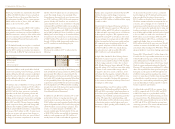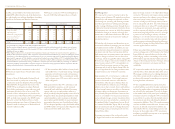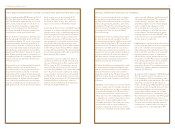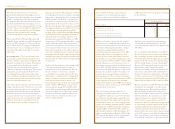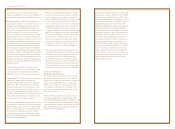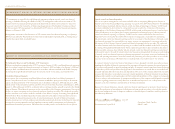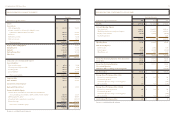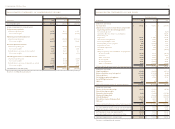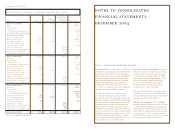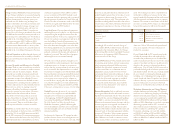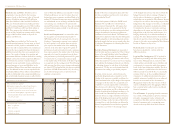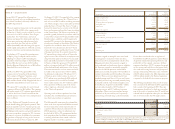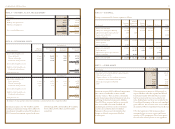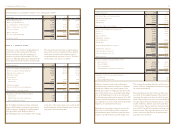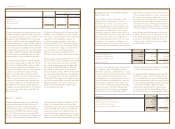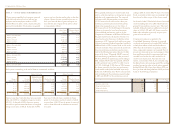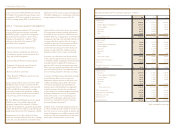North Face 2004 Annual Report Download - page 42
Download and view the complete annual report
Please find page 42 of the 2004 North Face annual report below. You can navigate through the pages in the report by either clicking on the pages listed below, or by using the keyword search tool below to find specific information within the annual report.
79vf corporation 2004 Annual Report
Royalty Income and Other: Royalty income is
recognized at rates specified in the licensing
contracts, based on the licensees’ sales of licensed
products. Royalty income was $49.9 million in
2004, $28.6 million in 2003 and $20.5 million in
2002, net of related expenses (including amortiza-
tion of licensing intangible assets) of $18.2 million
in 2004, $7.6 million in 2003 and $4.6 million in
2002. This category also includes the equity in
income of 50%-owned joint ventures and, in 2004,
charges of $9.5 million related to disposal of a
business unit (Note C).
Income Taxes are provided on Net Income for
financial reporting purposes. Income taxes are based
on amounts of taxes payable or refundable in the
current year and on expected future tax consequences
of events that are recognized in financial statements
in different periods than they are recognized in tax
returns. As a result of timing of recognition and
measurement differences between financial accounting
standards and income tax laws, temporary differences
arise between the amounts of pretax financial
statement income and taxable income and between
reported amounts of assets and liabilities in the
Consolidated Balance Sheets and their respective tax
bases. Net deferred income tax assets reported in the
Consolidated Balance Sheets reflect estimated future
tax effects attributable to these temporary differences
and carryforwards, based on tax rates in effect for the
years in which the differences are expected to reverse.
Valuation allowances are used to reduce these net
deferred tax assets to amounts considered likely to be
realized. U.S. deferred income taxes are not provided
on undistributed income of foreign subsidiaries where
such earnings are considered to be permanently
invested. The provision for Income Taxes also includes
estimated interest expense related to tax deficiencies
and assessments.
Stock-based Compensation is accounted for under
the recognition and measurement principles of
APB Opinion No. 25, Accounting for Stock Issued to
Employees. Compensation expense is not required
for stock options, as all options have an exercise
price equal to the market value of the underlying
common stock at the date of grant. For grants of
performance-based restricted stock units, compensa-
tion expense equal to the market value of the shares
expected to be issued is recognized over the three
year performance period being measured. For grants
of restricted stock, compensation expense equal
to the market value of the shares at the date of grant
is recognized over the vesting period. The following
table presents the effects on net income and earnings
per share if VF had applied the fair value recognition
provisions of FASB Statement No. 123, Accounting
for Stock-Based Compensation, to all stock-based
employee compensation:
Details of the stock compensation plans and of the
fair value assumptions used above for stock options
are described in Note P.
In the fourth quarter of 2004, the FASB issued
Statement No. 123 (R), Share-Based Payment.
This revision to Statement No. 123 requires that
compensation expense be recognized for the fair
value of stock options over their vesting period and
changes the method of expense recognition for
performance-based stock awards. The Statement is
required to be adopted no later than the third quarter
of 2005 and applies to all outstanding stock options
and stock awards that have not yet vested at the date
of adoption. Management is evaluating the effects
of this Statement.
Derivative Financial Instruments are measured at
their fair value and are recognized as Other Current
Assets or Accrued Liabilities in the Consolidated
Balance Sheets. VF formally documents hedged
transactions and hedging instruments, and assesses,
both at the inception of a contract and on an ongoing
basis, whether the hedging instruments are effective
in offsetting changes in cash flows of the hedged
transactions. VF does not use derivative financial
instruments for trading or speculative purposes.
If certain criteria are met, a derivative may be
specifically designated and accounted for as (1)
a hedge of the exposure to variable cash flows for
a forecasted transaction or (2) a hedge of the exposure
to changes in the fair value of a recognized asset
or liability or an unrecognized firm commitment.
The criteria used to determine if hedge accounting
treatment is appropriate are (1) to designate and
identify the appropriate hedging instrument to be
used to reduce an identified exposure and (2) to
determine if there is a high correlation between the
value of the hedging instrument and the identified
exposure. Changes in the fair value of derivatives
accounted for as cash flow hedges are deferred in
Other Comprehensive Income and recognized in
Net Income as an offset to the earnings impact
of the hedged transaction at the time in which the
hedged transaction affects earnings. Changes in
the fair value of derivatives accounted for as fair
value hedges are recognized in Miscellaneous Income
or Expense as an offset to the earnings impact of the
hedged item. The changes in fair value, as evaluated
and adjusted each quarter, are deferred in Other
Comprehensive Income or reported in earnings,
depending on the nature and effectiveness of the
hedged item or the risk. Any ineffectiveness in a
hedging relationship is recorded immediately in
earnings. For those limited number of derivatives
that do not meet the criteria for hedge accounting,
changes in fair value are recognized in Miscellaneous
Income or Expense as they occur.
Reclassifications: Certain prior year amounts
have been reclassified to conform with the
2004 presentation.
Legal and Tax Contingencies: VF is involved in
legal and tax proceedings and claims arising from
time to time. Management, in connection with
outside advisers, periodically assesses liabilities and
contingencies in connection with these matters,
based on the latest information available. For those
matters where it is probable that a loss has been or
will be incurred, we record the loss, or a reasonable
estimate of the loss, in the consolidated financial
statements. As additional information becomes
available, estimates of probable losses are adjusted
based on an assessment of the circumstances.
Management believes that the outcome of these
matters, individually and in the aggregate, will not
have a material adverse effect on the consolidated
financial statements.
Use of Estimates: In preparing financial statements
in accordance with generally accepted accounting
principles, management makes estimates and
assumptions that affect amounts reported in the
financial statements and accompanying notes.
Actual results may differ from those estimates.
In thousands, except per share amounts 2004 2003 2002
Net income (loss), as reported $ 474,702 $397,933 $ (154,543)
Add employee compensation expense for performance –
based restricted stock units and restricted stock
included in reported net income, net of income taxes 6,793 990 627
Less total stock-based employee compensation expense
determined under the fair value-based method,
net of income taxes (18,757) (13,648) (15,512)
Pro forma net income (loss) $ 462,738 $385,275 $ (169,428)
Earnings (loss) per common share:
Basic –as reported $4.30 $3.67 $ (1.49)
Basic –pro forma 4.19 3.55 (1.63)
Diluted – as reported $4.21 $3.61 $ (1.38)
Diluted – pro forma 4.10 3.49 (1.52)


